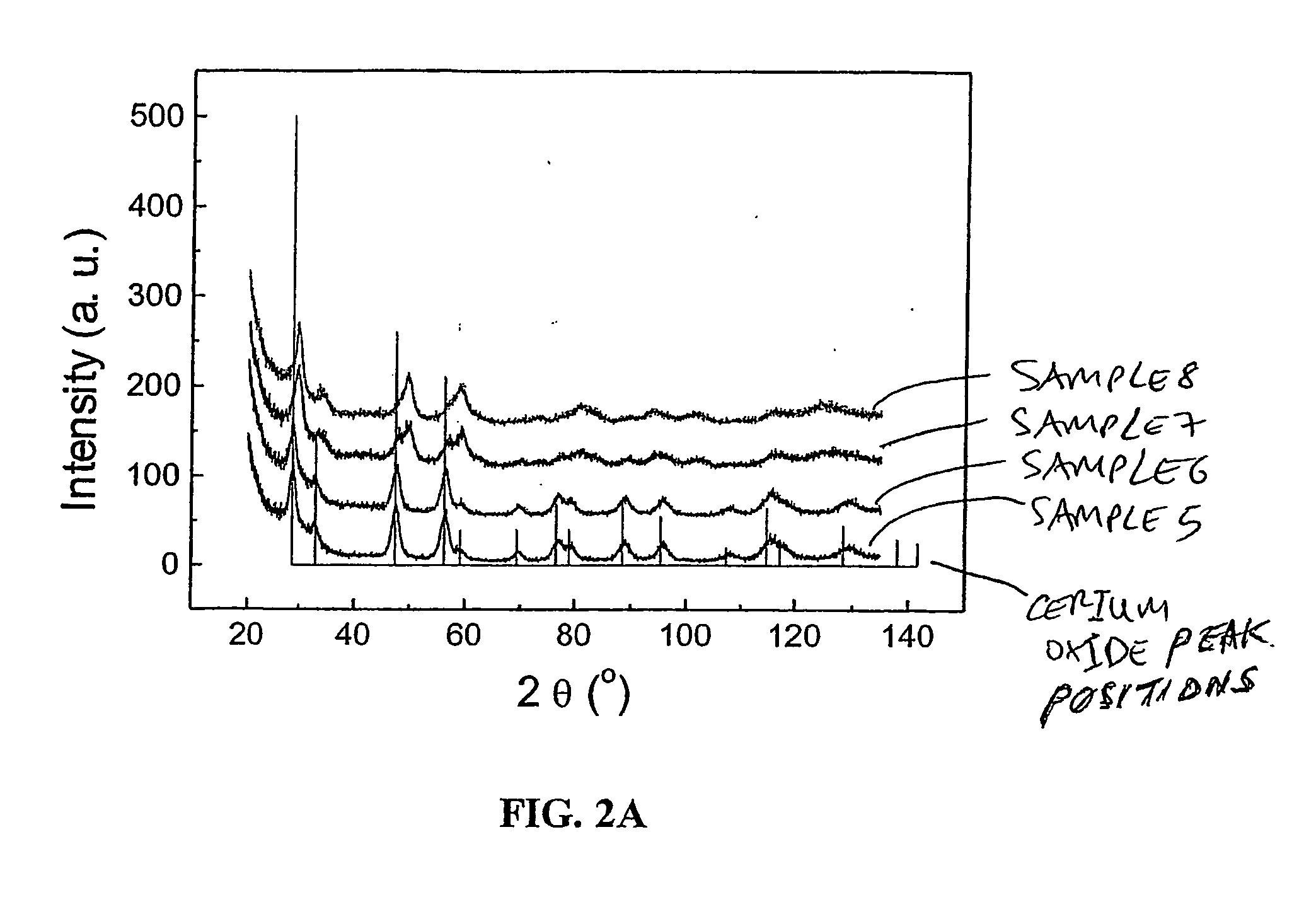Method for preparing nanoparticles comprising cerium oxide and zirconium
a technology which is applied in the field of nanoparticle preparation of cerium oxide and zirconium, can solve the problems of large amount, and achieve the effect of controlling reaction time and fast initial mixing ra
- Summary
- Abstract
- Description
- Claims
- Application Information
AI Technical Summary
Benefits of technology
Problems solved by technology
Method used
Image
Examples
examples 1-4
Preparation of Unsintered Nanoparticle Samples 1-4
[0045] For the preparation of Sample 1, the following aqueous solutions were prepared: 375 ml of 0.072 M cerium nitrate, 375 ml of 0.008 M zirconium oxychloride, and 750 ml of 0.5 M hexamethylenetetramine (HMT). Each of these three solutions was stirred for 20 minutes. The HMT solution and the cerium nitrate solution were then added in rapid succession to the zirconium oxychloride solution. The resulting mixture had molar percentages of 10% zirconium and 90% cerium. This mixture was stirred overnight for approximately 20 hours. The resulting mixture after such stirring was centrifuged at 9000 rpm for 30 minutes to recover the precipitate. The precipitate was then dried in an oven at 40° C. For the preparation of Samples 2,3 and 4, the same procedure was used with the modification that the molarity of the starting solutions was changed so that the amount of zirconium as a molar percentage of the cerium amount in the final solution wa...
examples 5-8
Preparation of Sintered Nanoparticle Samples 5, 6, 7, 8
[0046] These samples were prepared by sintering Samples 1, 2, 3 and 4, respectively, according to the following procedure. The temperature was ramped up at a rate of 100° C. per hour for 5.3 hours from 20° C. to bring the temperature up to 550° C. The temperature was held at 550° C. for 1 hour. The temperature was then ramped down at a rate of −100° C. per hour for 5.30 hours to reach a final temperature of 20° C. All samples were yellow in color. The particle diameter of Sample 6 was determined to be ˜5 nm, determined by X-ray diffraction.
examples 9-10
Preparation of Unsintered Nanoparticle Samples 9-10
[0047] For the preparation of Sample 9, the following starting solutions were prepared: 0.0356 M cerium nitrate (1.835 g in 150 mL water), 0.0133 M zirconium oxychloride (0.430 g in 100 mL water), 0.5 M HNMT (7.011 g in 100 mL water). Each of these three solutions was stirred for 20 minutes. The HMT solution and the cerium nitrate solution were combined, and the resulting mixture was stirred for 2 hours. The zirconium oxychloride solution was then added and the resulting second mixture had molar percentages of 20% zirconium and 80% cerium. This second mixture was stirred overnight for approximately 20 hours. The second mixture after such stirring was centrifuged at 9000 rpm for 30 minutes to recover the precipitate. The precipitate was then dried in an oven at 40° C. For the preparation of Sample 10 the above procedure was used with the modification that the molarity of the starting solutions were changed so that the zirconium mola...
PUM
| Property | Measurement | Unit |
|---|---|---|
| Temperature | aaaaa | aaaaa |
| Temperature | aaaaa | aaaaa |
| Temperature | aaaaa | aaaaa |
Abstract
Description
Claims
Application Information
 Login to View More
Login to View More - R&D
- Intellectual Property
- Life Sciences
- Materials
- Tech Scout
- Unparalleled Data Quality
- Higher Quality Content
- 60% Fewer Hallucinations
Browse by: Latest US Patents, China's latest patents, Technical Efficacy Thesaurus, Application Domain, Technology Topic, Popular Technical Reports.
© 2025 PatSnap. All rights reserved.Legal|Privacy policy|Modern Slavery Act Transparency Statement|Sitemap|About US| Contact US: help@patsnap.com



